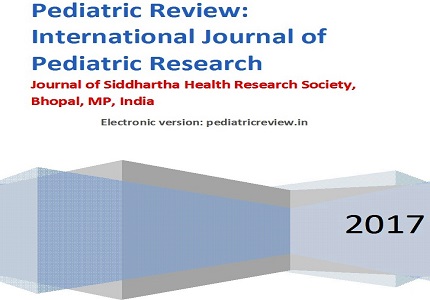Analysis of the maternal factors associated with VLBW babies
Abstract
Introduction: VLBW is associated with increased mortality and morbidity. In country like India where poverty, illiteracy & low socio-economic factors play a major role, incidence of VLBW & its complications can be reduced by targeting on the socio-demographic, obstetric factors, maternal nutrition & health education.
Methodology: This is a Prospective study in a single centre over a period of 1 year. All newborns admitted to the neonatal unit during the study period with birth weight < 1500 gram were included and Still births & babies with major congenital malformations were excluded. An equal number of newborns with birth weight > 2500 gram were selected by simple randomized technique on same day of the selection of study group & were used as a control population to study maternal factors. Maternal factors analyzed in the study include Age of mother, Parity, Birth interval, Height, Weight, Mid arm circumference, Literacy level, Per capita income per month, Family structure, Mother's occupation, Antenatal care, Bad obstetric history, Maternal disease during the antenatal period Neonatal details of birth weight, gestational age, sex of the baby was collected.
Results: Higher incidence of VLBW babies were noted among young mothers, primiparity, when birth interval was < 2 years, maternal weight < 40kg and with MAC < 20 cm. Incidence of VLBW was more in mothers who were illiterate and with bad obstetric history.
Conclusion: A well-nourished multiparous mother between 20-30 years with birth interval of > 2years with good literacy & without any BOH has the best chance of producing a good weight baby.
Downloads
References
2. Khoshnood B, Wall S, Lee KS. Risk of low birth weight associated with advanced maternal age among four ethnic groups in the United States.Matern child Health J. 2005 Mar:
9 (1): 1-2. [PubMed]
3. Roth J, Hendrickson J, Schilling M, Stowell DW. The risk of teen mothers having low birth weight babies: implications of recent medical research for school health personnel. J Sch Health. 1998 Sep;68(7):271-5. [PubMed]
4. Yoder BA, Young MK. Neonataloutcomes of teenage pregnancyin amilitarypopulation. Obstet Gynecol. 1997 Oct;90(4 Pt 1):500-6. [PubMed]
5. Torres - Arreola IP, constantino - corsa P, Flores - Hernandez S. Socio economic factors and very low birth weight in Mexico. BMC Public Health20055:20. https://doi.org/10.1186/1471-2458-5-20.
6. Gopalan C. Low birth weight. In: Nutritional Research In Southeast Asia. 1st edn. New Delhi; AITBS Publishers and Distributors, 1996; 13-31.
7. Maddah M, Karandish M, Mohammadpour-AhranjaniB, Neyestani TR, Vafa R, Rashidi A. Socialfactors and pregnancyweight gain in relation to infantbirth weight: a study in
public healthcenters in Rasht, Iran. Eur J ClinNutr. 2005 Oct;59(10):1208-12. [PubMed]
8. Hogan DP, Park JM. Familyfactors and social support in the developmentaloutcomes of very low-birth weightchildren. ClinPerinatol. 2000 Jun;27(2):433-59. [PubMed]
9.Khan N, Jamal M. Maternal risk factors associated with low birth weight. J Coll Physicians Surg Pak. 2003 Jan;13(1):25-8. [PubMed]
10. Maruoka K, Yagi M, Akazawa K, Kinukawa N, Ueda K, Nose Y. Risk factors for low birthweight in Japanese infants. Acta Paediatr. 1998 Mar;87(3):304-9.
11. Kirchengast S, Hartmann B. Impact of maternal age and maternalsomaticcharacteristics on newbornsize. Am J Hum Biol. 2003 Mar-Apr;15(2):220-8. [PubMed]
12. Sachar RK, Soni RK, Singh H, Kaur N, Singh B, Kumar V, Sofat R. Correlation of some maternal variables with birth weight. Indian J Matern Child Health. 1994 Apr-Jun;5(2):43-5.
13. Amin N, Abel R, Sampathkumar V. Maternal risk factors associated with low birth weight. Indian J Pediatr. 1993 Mar-Apr;60(2):269-74. [PubMed]
14. Dhar GM, Shah GN, Bhat TA, Butt N. Low birth weight: an outcome of poor socioobstetric interaction: Indian J Matern Child Health, 1991; 2(1): 10-3. [PubMed]
15. Malik S, Ghidiyal RG, Udani R, Waingankar P. Maternal biosocial factors affecting low birth weight. Indian J Pediatr. 1997 May-Jun;64(3):373-7. [PubMed]
16. Nair NS, Nayar V, Thankam, M. A study of birth weight of term infants at Calicut. Journal of Obstetrics and Gynaecology of India, 1963; 13:488-94.
17. Deshmukh JS, Motghare DD, Zodpey SP, Wadhva SK. Low birth weight and associated maternal factors in an urban area. Indian Pediatr. 1998 Jan;35(1):33-6. [PubMed]
18. Arif MA, Qurreshi AH, Jafarey SN, Alam SE, Arif K. Maternal sociocultural status: a novel assessment of risk for the birth of small for gestational age, low birth weight infants: J ObstetGynaecol Research, 2012;24(3):215-22.

Copyright (c) 2017 Author (s). Published by Siddharth Health Research and Social Welfare Society

This work is licensed under a Creative Commons Attribution 4.0 International License.


 OAI - Open Archives Initiative
OAI - Open Archives Initiative


